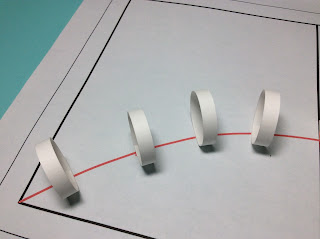Galileo's Parabolic Experiment
Slow Motion Video of the Marble Rolling Down the Ramp and Through the Loops
In the late 1590's, Galileo studied the physics of motion made popular by Aristotle at the University of Pisa. He then went on to teach at the University of Padua where he contradicted Aristotle's theory of projectile motion. He proved that motion exerts forces on the projectile in two directions, vertically and horizontally at the same time. He proved these results physically by rolling a metal ball down an inclined plane and allowed it to roll off the end to complete its fall. He also proved it mathematically with equations and visually by seeing that these forces create a curve which has the same exact mathematical shape as a parabola.
In this blog posting, I recreate Galileo's parabolic experiment using an assembly similar to the following apparatus. (My files contain all of the necessary components to make the apparatus in paper. It can easily be cut by hand, Silhouette, Cricut or another die cutting machine.)
At the Galileo Museo in Italy there is an apparatus which can demonstrate Galileo's theory of parabolic trajectory of projectiles.
Here is its description from the museum catalog. https://catalogue.museogalileo.it/object/ApparatusToDemonstrateParabolicTrajectoryProjectiles.html
"The apparatus was probably first described by Willem Jacob 's Gravesande in Physices elementa mathematica, experimentis confirmata (3rd ed., Leiden, 1742). It demonstrates experimentally that gravitational acceleration causes a body launched horizontally to describes a parabolic trajectory.
A wooden base, fitted with leveling screws, holds a stand with a quarter-circle track and vertical panel on which a series of four brass rings are fixed at equal distances along a parabola. A ball falling down the track experiences a constant acceleration. When no longer supported by the track, the ball's horizontal projection is combined with the natural motion of uniformly accelerated fall; the ball's path thus becomes parabolic, as evidenced by the fact that it goes through the entire series of rings. The experiment confirms Galileo's discovery of the parabolic trajectory of bodies as the result of the combination of horizontal projection and free fall, defined by the Pisan scientist in c. 1609 and first published in the Giornata Quarta [Fourth Day] of the Discorsi and dimostrazioni matematiche intorno a due Nuove Scienze (Leiden, 1638). Provenance: Lorraine collections"
I copied the photo of the apparatus to Silhouette and traced the trajectory (red and blue curves) that the projectile would take. I confirmed that the two curves were as follows:
The red curve represents Galileo's parabola: Physics tells us the functional form of the parabolic ball flight is y=ax^2. By measuring points on the picture (done in centimeters) and curve fitting we find a=-.041. We also know from physics that a=-g/(2v^2) where v is the velocity vector in the x direction. We find the velocity coming off Galileo’s ramp, after converting units from centimeters, was 3.5 feet/sec.
The blue line represents the curve that is formed when a circle is divided into fourths.
I created a template of the apparatus with both the red and blue curves and I put red lines where the loops would be. Using this template, I determined my radius of the ramp would be 3.5 inches.
I used TurtleStitich to create the ramp. The height of the ramp is the radius.
I made a 1 inch circle to simulate the loop in the apparatus in TurtleStitch.
I made a frame to contain the components of the apparatus in TurtleStitch.
Make the Apparatus
Here is the PDF. I used 65 lb. cardstock, Glue Dots and a marble.
Here is the .Studio file.
Here is the SVG. The file extends beyond the scope of the viewing field. Zoom out to see the entire file.
Make the ramp by curving the ramp base and bending the tabs at a right angle (not shown). Apply glue to each tab and adhere the side of the ramp. Repeat for the other side of the ramp. Glue the ramp to the template following the blue line.
Glue the four loop pieces into a circle.
Glue to the center of the red line which is perpendicular to the parabola.
Cut the outer black line with scissors.
Make the Frame
Use the directions from the shuffleboard frame blog posting, https://papercraftetc.blogspot.com/2023/02/a-stem-project-making-shuffleboard-game.html to make the frame.
Assemble the Frame To the Apparatus
Apply glue to the frame.
Apply a few drops of glue to the template. Align the template on the backing and adhere the frame.
Experiment Using a Marble
Place and release the marble at the top of the blue line. The marble will roll down the ramp. The red parabolic line represents the path the marble will take through the four loops.
For more information about Galileo's discovery of the Parabolic Trajectory, please read this Scientific American article, https://www.scientificamerican.com/article/galileos-discovery-of-the-parabolic/










No comments:
Post a Comment